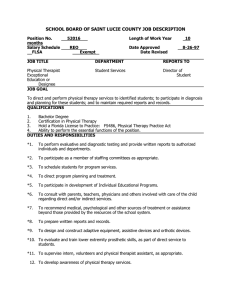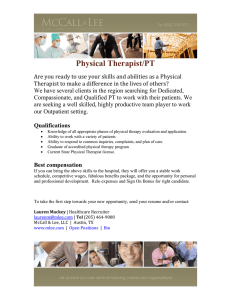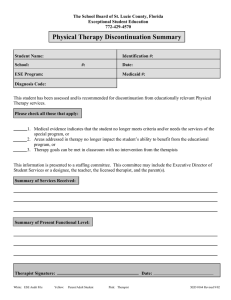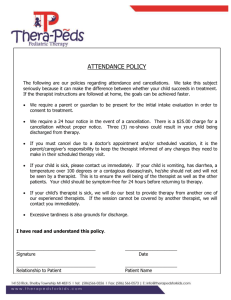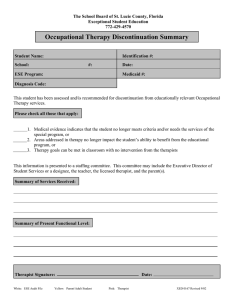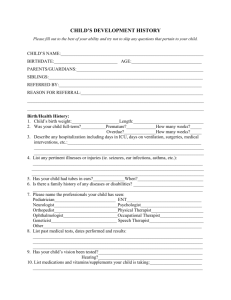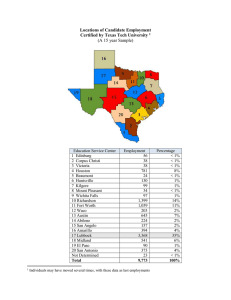TREATMENT AND DISORDERS
advertisement
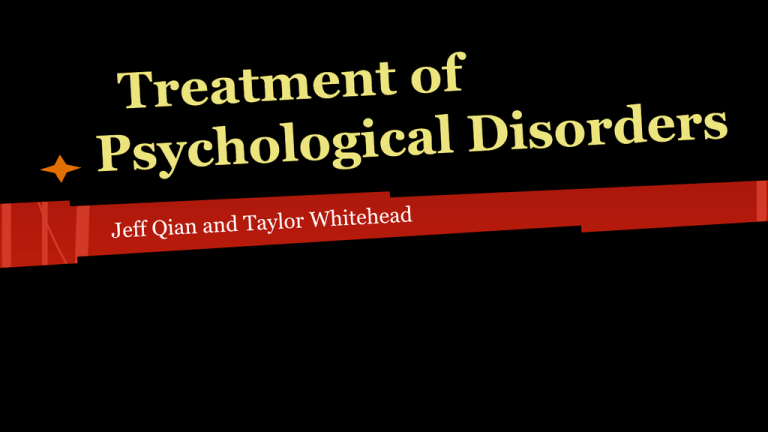
Insight into true nature of a disorder can be derived from examining the strategy that is most effective in treating the disorder. Psychoanalytic approach to treatment of abnormal behavior is rooted in the concept of insight. Psychoanalysis (Psychoanalytic Therapy) ● Developed by Freud ● Focuses on probing past defense mechanisms of repression and rationalization to understand the unconscious cause of a problem ○ Free Association: patient reports any and all conscious thoughts and ideas ■ This hints to the nature of unconscious conflict ○ Dreams: images and occurrences in dreams are actually symbols representing the truly meaningful content of dreams ○ Transference: patient pushes thoughts and feelings about certain people or events onto therapist ■ Reveals nature of patient’s conflicts Risks • *Countertransference*: occurs when therapist pushes his/her feelings onto patient Therapist strives to remain detached from the patient: resists emotional/personal Insight Therapies: Psychoanalytic and Humanistic (cont.) Instead of treating the person seeking help as a patient, the humanistic approach treats the individual. • • Humanistic Therapy Client-Centered Therapy ○ Invented by Carl Roger ○ Clients can only be understood in terms of their own reality ○ Focuses on client’s present perception of reality ○ Goal is to help client realize full potential through self-actualization ○ Therapist is open, honest, and expressive rather than being detached ○ Therapist provides unconditional positive regard to help client reach a state of unconditional selfworth ○ Final key to success is the therapist’s ability to view world from client’s eyes Gestalt Therapy ○ Developed by Fritz Perls ○ Combines both physical and mental therapies ○ Blend awareness of unconscious tensions with the belief that one must become aware of and deal with those tensions by taking personal responsibility Behavioral Therapy Behavioral Therapy ● Short-term process ● Treats symptoms (no deep underlying cause of problem) ● Abnormal behavior is the symptom and problem ○ Counterconditioning: technique where a response to a given stimulus is replaced by a different response ■ Aversion Therapy: aversive stimulus is repeatedly paired with the behavior the client wishes to stop ■ Systematic Desensitization: replace one response with another response Other Forms of Behavioral Therapy • • • • • Extinction Procedure: weaken Maladaptive responses Flooding: exposing client to the stimulus that causes the undesirable response Implosion: Client imagines disruptive stimuli rather than confronting it Operant Conditioning: positive and negative reinforcement Behavioral Contracting: therapist and client draw up a contract that they both agree to abide Cognitive Therapy ● Changing the ways people think about situations in order to change behaviors ○ ○ Rational-Emotive Behavior Therapy (REBT) ■ Developed by Albert Ellis ■ Confronted with situations, people will recite statements to themselves that express maladaptive thoughts ■ Goal is to change maladaptive thoughts and emotional response by confronting the irrational thoughts directly Cognitive Therapy ■ Developed by Aaron Beck ■ Focus on maladaptive schemas ■ Goal is to eliminate or modify the individual’s maladaptive schemas Biological Therapies ● Medical approaches to behavioral problems ● Used in conjunction with other forms of treatment ○ ○ Electroconvulsive Therapy ■ High voltages of electricity are passed across a patient’s head ■ Successful in treatment of major depression, however only used if all other treatments for depression have failed ● Risks ○ Temporary Amnesia ○ More permanent memory loss ○ Can result in seizures Psychosurgery ■ Most well-known form is the prefrontal lobotomy ■ Parts of frontal lobes are cut off from the rest of the brain ● Psychopharmacology ○ Treatment of psychological and behavioral maladaptives with drugs ■ Antipsychotics (Clozapine, Thorazine, Haldol) ● Reduce symptoms of Schizophrenia by blocking neural receptors of dopamine ○ ● ■ Risks ■ Jerky movements ■ Tremors ■ Muscle Stiffness Clinician decides if disorder or side effects are worse Antidepressant Drugs ● MAO Inhibitors (Eutron) ○ Increase serotonin and norepinephrine in the synaptic cleft ○ Produce increase by blocking monoamine oxidase which are responsible for the breakdown of many neurotransmitters ■ Risks ● ● ● Tricyclics (Norpramin) ○ Used frequently ○ Amitriptyline and Imipramine (other drugs) increase amount of serotonin and norepinephrine Selective Reuptake Inhibitors (Prozac) ○ Increase amount of neurotransmitters at the synaptic cleft ○ Block the reuptake mechanism of the cell that released neurotransmitters ○ Indirect mechanism of action means fewer side effects Anxiolytics (Xanax) ○ Depress central nervous system and reduce anxiety while increasing feeling of well-being and reducing insomnia ■ Risks ● ● Include barbiturates which are rarely used because of their potential for addiction and danger when mixed with other drugs Benzodiazepines (Valium and Librium) ○ Cause muscle relaxation and feeling of tranquility Modes of Therapy ● Group Therapy ○ Clients meet together with a therapist as an interactive group ○ Group members learn from each other ○ Therapist is moderator ■ ■ Advantages ● Less expensive ● Group dynamic is therapeutic in itself Disadvantage ● Psychological effect is diluted because attention is focused on group rather than individual ○ Twelve Step Programs ■ Not moderated by professional psychotherapists ■ Combination of spirituality and group therapy ■ Focus on strong support system ● Couples or Family Therapy ○ Treatment arose out of simple observation that dysfunctional behavior affects the afflicted person’s loved ones ○ Help with communication and resolve conflicts ○ Focus on whole family instead of just “ill patient” ■ Couples Therapy ● Approach couple dyad as a system that involves complex interactions ■ Family Therapy ● Allows family members to express their feelings to each other and to therapist ● Encourages family members to listen to each other ● Therapy doesn’t minimize or get rid of stress but teaches family to overcome the stress • • • • • • • Manifest Content: images and occurrences Latent Content: truly meaningful, content of dreams Genuineness: Therapist is open, honest, and expressive Accurate Empathic Understanding: therapist’s ability to view the world from the eyes of the client Negative Triad: involves negative view of self, of the world, and of the future, these views are learned from experience Arbitrary Inference: person draws conclusion without evidence Dichotomous Thinking: involves all-or-none conceptions of situations
